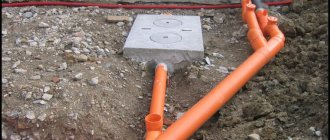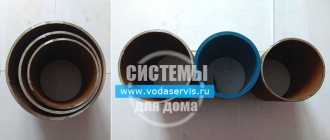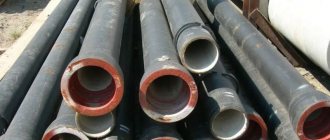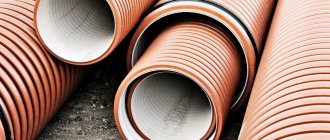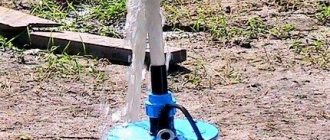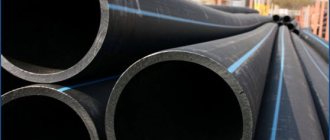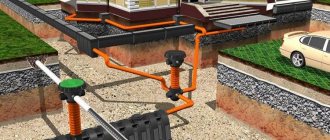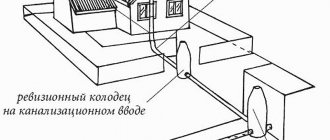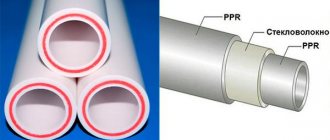Are you concerned about the arrangement of internal communications and the drainage system outside the house? Agree, it’s great when a country house has all the benefits of civilization, despite its remoteness from the metropolis.
But to build a system, you need sewer pipes for external sewerage, and you don’t know which ones are best to choose?
We will tell you which material is suitable for various operating conditions - the article discusses the characteristics of pipes made from existing materials, the advantages and disadvantages of each option.
There is also a rating of the best manufacturers of plastic and cast iron pipelines, selected photographs depicting their products and video recommendations from sewerage professionals.
Criterias of choice
The external pipeline operates in unfavorable street conditions. Incorrectly selected pipes for external sewerage can deform under soil pressure (during rising groundwater levels) or change properties due to severe frost. Violation of the integrity of the system will result in unexpected expenses for repairs (the damaged fragment will have to be replaced).
When designing external sewerage, they try to find a compromise between the need to ensure a long service life of the system and optimize costs. External sewerage pipes must meet the requirements for:
- strength (ability to withstand environmental stress);
- wear resistance (resistance to internal aggressive environment);
- affordability.
Areas of application
The easiest answer would be: everywhere. Sewage now exists in all cities and towns, in all industries, in agriculture, in mines and oil production complexes, sinter plants and farms, railway stations and airports.
Almost all underground infrastructure of cities falls under the concept of “sewage” - after all, communication lines, the Internet, underground power networks laid in a shell or in boxes are also called sewerage. Houses without sewage systems now remain mainly in small villages and towns, but even there, septic tanks and systems are gradually being built for each house.
Polyethylene is the most popular material for external and internal sewage systems. It is durable and at the same time plastic. With slight movements of the earth, polyethylene communications will retain their integrity when steel or, especially, cast iron pipes break.
In cases of very heavy loads - depths of more than 10 m, aggressive or toxic wastewater and special requirements for the integrity of pipelines - polyethylene pipelines are not used.
Types and characteristics
For external sewerage, several types of materials with different physical and chemical properties are used.
Cast iron pipes
A classic method of arranging a sewer system that has existed for decades. The widespread distribution of cast iron products was due to a complex of reasons:
- High mechanical strength and long service life.
- Resistant to temperature changes and aggressive environments.
- Easy installation.
Cast iron is expensive, heavy and efficient Source krasnodar.blizko.ru
With the development of technology, cast iron sewer pipes for external sewerage have lost relevance due to some features:
- Heavy weight, forcing the use of special equipment during assembly.
- A defect in the internal cavity, leading over time to a narrowing of the lumen.
Ceramic pipes
Ceramic pipelines have been known since antiquity. Modern factories produce ceramic products with a diameter of 100-600 mm, which have undoubted advantages:
- Service life 30-40 years.
- Easy installation and low installation cost.
- Chemical inertness, temperature stability and environmental friendliness.
- Low internal surface roughness.
Disadvantages of ceramic products:
- Fragility (before assembly they must be checked for cracks).
- Short length (increases the number of joints of external sewerage).
The fragility of ceramics is leveled by strict adherence to installation technology Source alemsohbet.co
Asbestos-cement pipes
Although the material contains asbestos fibers, their chemical bonding with cement makes the products safe. The advantages include:
- Light weight and easy installation.
- Durability.
- Low thermal conductivity (almost no problems with freezing).
- Resistance to aggressive environments.
The main disadvantage of asbestos-cement products is fragility. Mechanical loads (especially during transportation) are fraught with cracks and chipped edges.
Polypropylene pipes
Plastic polypropylene pipes (Russian name - PPR, international - PPR) are suitable for assembling an external sewer system in a country house. Their popularity is a consequence of their advantages:
- Long service life. Manufacturers guarantee 30-50 years of flawless operation.
- Light weight and elasticity. Savings on transportation and installation.
- Resistance to high temperatures (operating mode - 80°C; emergency short-term temperature of 100°C does not reduce service life).
Polypropylene - corrugated on the outside, smooth on the inside Source obustroeno.com
See also: Catalog of companies that specialize in water supply and sewerage.
- Chemical inertness. The material is resistant to corrosion and does not emit harmful substances.
- Smooth inner layer.
- Diversity. Selection of models and parts of any configuration. Options are available reinforced with fiberglass or aluminum.
Flaws.
- Products made from PPR cannot be bent. To organize bending or turning, tees and angles are used.
- A welding machine is used for connection. Thermal welding creates a seam that is uniform in structure.
Polyethylene pipes
What is uPVC
Very often you can hear the name “PVC sewer pressure pipe” without the prefix “N” (unplasticized). In professional terms, this is acceptable, since experts know that pressure pipes are not made from modified polyvinyl chloride. The material used for these systems is uPVC (unplasticized polyvinyl chloride) - a vinyl chloride polymer that does not contain plasticizers. Plasticizers are introduced to increase the fluidity and elasticity of the material, which contradicts the objectives of pressure pipes. The wall of the product must be as rigid as possible, designed to withstand pressure changes, especially when passing solid masses; its deformation can lead to a rupture, which is unacceptable in a sewer network.
Video description
The plastic variety (Russian name - PE, international - PE), is widely used in external drainage systems:
PVC pipes
Polyvinyl chloride sewer pipes (PVC in international transcription) are mainly used for arranging sewer systems in residential buildings. Among the advantages of such products are:
- long-term operational period (40-50 years);
- reduced flammability and ultraviolet resistance;
- resistance to corrosion and clogging;
- light weight and easy installation (easy to cut and bend).
Smooth PVC pipes are used where there is no heavy load on the ground Source yandex.by
When using, it is necessary to take into account some features of the products:
- The disadvantage that limits the use of PVC pipes is the high coefficient of thermal expansion (change in linear size under the influence of temperature). If the liquid is heated to 60°C or higher, the tightness of the joints decreases, which can lead to leakage.
- The plasticity of the material decreases at low temperatures. Operation of the pipeline without insulation is allowed in the range from 0 to -15°C.
HDPE pipe for installation of external sewer network>
HDPE pipes are made from low-density polyethylene using the continuous extrusion method. The material does not interact with acids, alkalis, organic acids and water - the higher its density, the more resistant it is to organic solvents.
Polyethylene pipes are practically not subject to corrosion, and a well-designed sewerage design and installation of the system guarantees long-lasting service - up to 50 years
The smooth inner surface of the pipes does not interfere with the free movement of wastewater containing mechanical particles and is not susceptible to silt and lime deposits.
The operating temperature range of polyethylene pipes for sewerage is from -20 to 60. HDPE pipes are used for the installation of pressure and free-pressure sewerage, drainage and stormwater systems.
When installing HDPE pipes, butt welding or electrofusion welding is used to connect them. This is a more labor-intensive process than the socket connection method, which is used when connecting PVC sewer system elements
For a short time, a polymer pipeline can withstand a temperature increase of up to 100. The pipes are installed underground or protected with insulating materials from exposure to sunlight - the material is sensitive to UV radiation and disintegrates quite quickly under its influence.
Advantages of sewerage with PVC pipes
The economic benefits of installing and using such a sewer system consist of:
- reducing transportation costs;
- saving consumables;
- low labor intensity during assembly;
- no operating costs.
Environmental safety during operation is also a valuable quality of products.
The appearance of PVC pipes has greatly simplified the organization of drainage Source remontsami.ru
Requirements for polyethylene pipes according to GOST
GOST standards according to which polyethylene sewer pipes are produced:
- socket pipes and fittings are produced in accordance with GOST 22689-2014;
- smooth – GOST 18599-2001;
- corrugated - GOST R 54475-2011.
All types of pipes must comply with GOST in shape, size, fit within dimensional tolerances, have nominal dimensions from the size range according to GOST, and have strength in accordance with regulatory documents. The most important parameters are the external and internal parameters, dimensions, shape of the socket, wall thickness, ring stiffness.
External sewerage: sequence of work
- Preparing a trench for sewerage. Its depth depends on the depth of soil freezing, the occurrence of groundwater and other features of the site. According to SNiP P-G.3-62, laying is carried out 0.5 m below the freezing mark. For pipes with a diameter of 110 mm, the trench width is 0.6 m.
Checking the slope angle is an important part of installation Source oxu.az
- Pipeline installation. Starts from the foundation of the house; the pipes are connected in a suitable manner and laid with a slope. If the sewerage system is laid shallow, the pipeline is insulated. At the exit from the building, the pipe must be insulated.
- The slope angle is checked , then the trench is backfilled.
Check valve device
Improper installation and violation of the rules of operation of the drainage system leads to an emergency situation - a blockage. The contents of the pipes can move back with all the ensuing consequences on the 1st floor. Installing a sewer check valve helps avoid dramatic events.
A check valve allows fluid to flow only outward; the return flow of wastewater is reliably shut off. A valve with a diameter of 110 mm is mounted on a common pipe, and a valve with a diameter of 50 mm is mounted on each PVC drain pipe.
Valves are made from cast iron, brass or steel. Due to the widespread use of PVC pipes, the demand for cheap and durable PVC valves has increased. By design, check valves are:
- PVC valve. Mounted on both horizontal and vertical pipes. Inside there is a reciprocating locking part - a plate fixed at a slight angle. It bends under the pressure of the escaping liquid, and the reverse flow presses it, blocking the return movement.
- Ball valve. The locking mechanism is a metal ball. If back pressure occurs, it is pressed against the hole and blocks the flow.
Cross-section of a ball check valve Source aglant.ru
conclusions
For each of the listed materials, there was its own niche among the various sewer systems.
Thus, asbestos-cement pipes are mainly used where large diameters are required (over 600 mm), that is, in industrial and municipal drainage systems.
For such tasks, reinforced concrete pipes are also successfully used, the strength of which allows for high-pressure flushing of the system.
In a centralized network for an object such as a cottage community or a small enterprise, it is appropriate to use ceramics or cast iron.
For non-pressure (gravity) sewerage with a diameter of up to 210 mm, polymer pipes are most suitable.
HDPE pipes have high chemical and corrosion resistance, therefore they are durable. Let's look at the technical properties and application of HDPE pipes in more detail.
The technical characteristics and markings of metal-plastic pipes are described in detail in this article.

